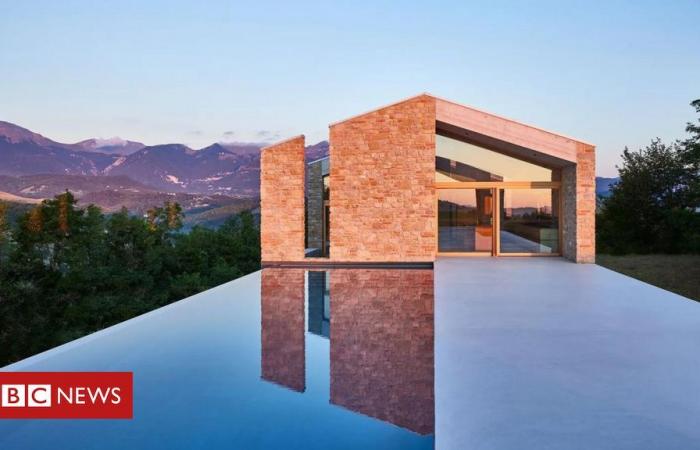The Ward House in Italy
- author, Dominic Lutyens
- Roll, BBC Culture*
-
1 hour ago
The idea of a “passive house” advocates buildings with low energy consumption, designed to prioritize solar energy and achieve a comfortable internal temperature.
This was a recurring approach among the finalist architects at the World Architectural Festival (WAF), an event that includes international awards for professionals in the field.
Event director Paul Finch told BBC Culture that he has seen “a much greater concern for sustainability, also reflected in the use of ecological materials and the adoption of passive house design principles”.
Held annually for three days in cities around the planet, the festival and its sister event, Inside World Festival of Interiors, offer a global overview of trends in architecture and interior design, respectively.
Around 550 pre-selected professionals present their projects to a jury, which includes architects, interior designers and even engineers.
The event judging process is atypically transparent.
On the last day, the pre-selected architects present their projects to another jury and compete for the awards for International Building of the Year, Landscaping of the Year, Future Project of the Year and Interior of the Year.
The next edition will take place at the end of the year in Singapore.
“Many houses have incorporated a creative approach to locations and their various constraints, transforming difficulties into opportunities,” says Finch.
“There is greater interest in knowing how much energy is spent on manufacturing materials,” adds Finch.
“Wood has become increasingly popular due to its carbon-absorbing properties. Architects also now tend to prefer modernization projects rather than those involving demolition and new construction.”
BBC Culture looks at eight projects featured in recent editions of WAF and Inside.
1. 19 Waterloo Street, Sydney, Australia
The house at 19 Waterloo Street created by SJB in Sydney does not overheat in summer, but lets in light in winter
Winner of the 2023 WAF Interiors Award, this home was designed by Sydney-based firm SJB.
It has an eccentric facade with irregularly sized and spaced windows, and a mosaic with recycled materials and broken bricks.
The numerous openings in the facade promote natural ventilation, eliminating the need for air conditioning.
2. House of Solid Stone, Jaipur, India
Credit, Barath Ramamrutham
In Jaipur, house was created with sandstone from a nearby quarry
This project recovers a material long neglected by local architects: sandstone, whose robust and sustainable qualities were ignored for decades in the region.
“We gave ourselves simple instructions: only stone should be used for construction. The site looked more like an archaeological dig than a construction site, where the line between what was ‘found’ and what was ‘made’ was blurred,” says Arjun Malik, architect who leads Malik Architecture.
The architects used stone extracted from a nearby quarry with traditional tools.
The stone, which has neutral tones, was left exposed throughout the interior to generate a homogeneous effect.
3. Casa Ward, Sarnano, Italy
The Ward House was designed to withstand earthquakes
This summer house, owned by a Swedish couple, epitomizes the current trend among architects to reuse existing materials found on site.
In this case, dramatic circumstances provided the raw material: a house overlooking the Sibillini mountains near Sarnano was almost reduced to rubble by an earthquake in 2016.
The new house was designed by Parisian architect Carl Fredrik Svenstedt and its concrete structure is clad in the remains of the original building, inside and out.
Its basic shape is modeled like a typical house, but with an unorthodox twist, making it appear cut into separate segments.
The house was built to withstand tremors and its indoor-outdoor connection is enhanced by huge windows that frame picturesque views, while an infinity pool reflects the sky.
4. Three Spring Residential Gallery, Bunurong Land, Australia
The vaulted ceiling is a striking feature of the residential gallery
This family home near Melbourne, designed by local architects KGA Architecture, houses a collection of works by Australian artists.
The asymmetrical construction has two separate areas indirectly connected by oblique corridors instead of conventional doors.
There is a spectacular double-height library with tall arched windows.
The windows overlook a garden with huge ornamental pools.
Inside, a warm, earthy palette (mainly shades of ochre, terracotta and eggplant) was chosen to integrate with the natural colors of the surrounding landscape.
5. Casa LRM, São Paulo, Brazil
The geometric LRM house, by Studio AG Arquitetura in São Paulo, is full of light and has an open living room
This rectangular and clearly geometric house occupies a long, narrow plot of land that has, on the sides, immediately adjacent properties.
The main objective of Studio AG Arquitetura, based in São Paulo (SP), was to create a feeling of more space, something that was achieved mainly with the installation of abundant glass and the connection of the house with a garden. Two additional floors were also built.
The long ground floor contains a kitchen, living room and dining room. A lawn adjacent to the dining room leads to a covered area for alfresco dining.
On the second floor are the bedrooms and, on the third, an office, gym, sauna and outdoor pool.
Floor-to-ceiling frosted windows provide privacy and encourage natural ventilation.
6. Mawhitipana House, Waiheke Island, New Zealand
Casa Mawhitipana prioritizes close contact between residents and nature
The owners of this holiday home told architects at Wellington-based firm MacKay Curtis that they would like to be in direct contact with nature, with outdoor areas to spend more time outside rather than inside.
Perched high on a steep slope, the largely timber-clad house offers stunning views of Mawhitipana Bay.
One deck external extends across the land and passes through trees without disturbing their roots.
The wooden shutters with slits promote natural ventilation and also allow the sound of the beach waves to enter the interior of the house.
7. Orla Apartment, Rio de Janeiro, Brazil
There are natural materials throughout the Orla Apartment, in Rio, designed by Studio Arthur Casas
The impressive panoramic view of Ipanema beach is one of the main attractions of this apartment.
The architects at Studio Arthur Casas, based in São Paulo (SP), designed the property for a couple with two young children.
The extensive use of natural materials throughout the home, including stone floors in the living room and wood-paneled walls, as well as sandy tones, contribute to creating a relaxing environment.
When demarcating outdoor views, these calming colors help draw the eye outdoors.
8. Flag House, Whistler, Canada
Credit, Fernando Guerra
The Flag House is in Canada, but was designed by a Brazilian office
Brazilian Studio MK27 designed Flag House, a vacation home in Whistler, north of Vancouver.
Its owners had seen some MK27 projects in Brazil and commissioned the studio to design their home.
The studio, founded by Marcio Kogan in the 1970s, is known for its modernist houses adapted for a tropical climate.
Even with Canada’s less-than-tropical climate, the architects applied one of their key principles in this project: establishing a strong connection between the interior and exterior.
The horizontal house, relatively low, integrates perfectly with the landscape.
It is made up of two square shapes, one placed on top of the other.
The largest, a living space with a glass facade, is supported by a base covered in dark wood; the upper floor appears to float above this “lower box”.
*This is an edited version of an article originally published in English on BBC Culture. To read the original version, Click here.
Tags: Architecture houses awarded beautiful sustainable Brazil
--





